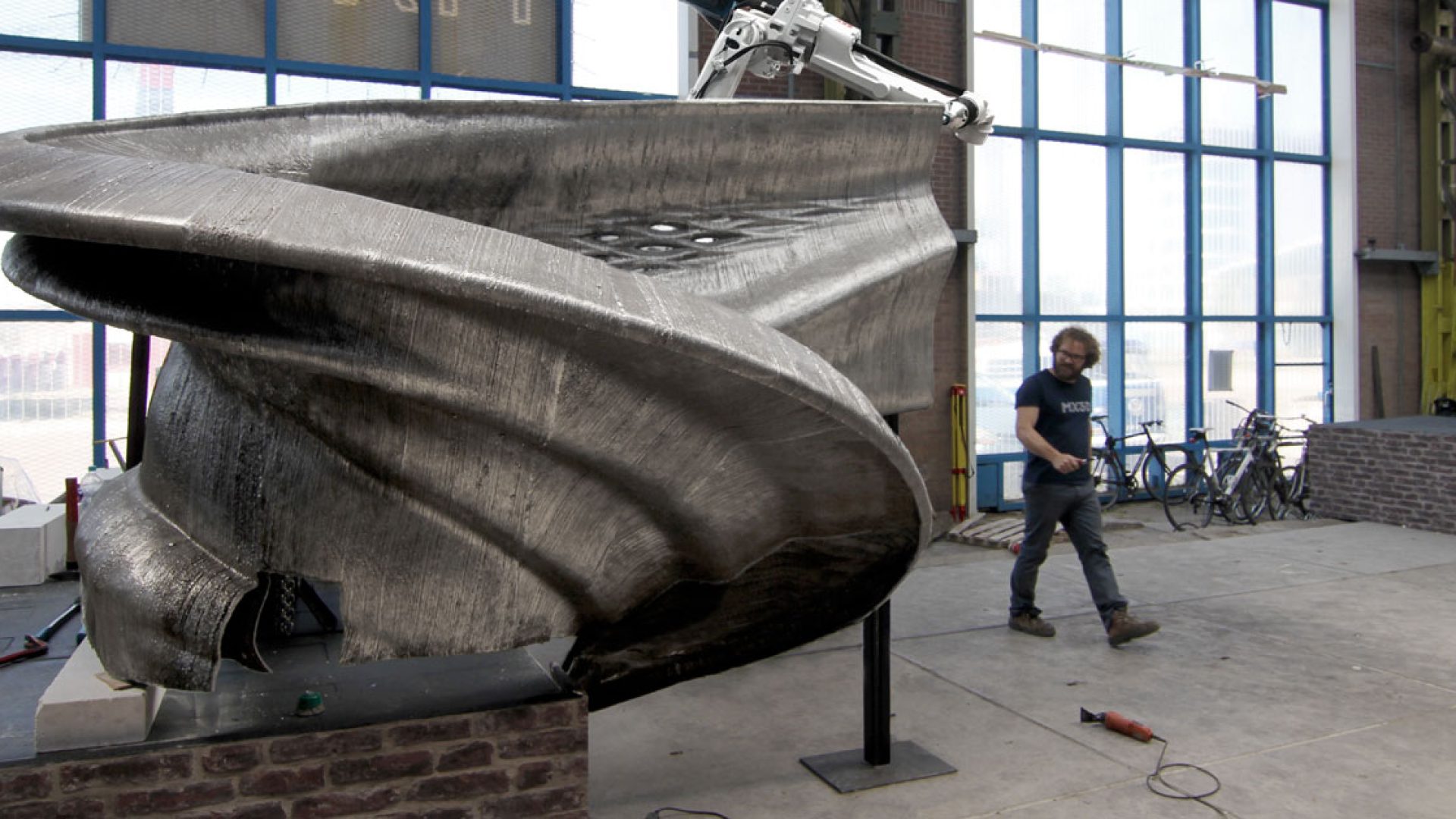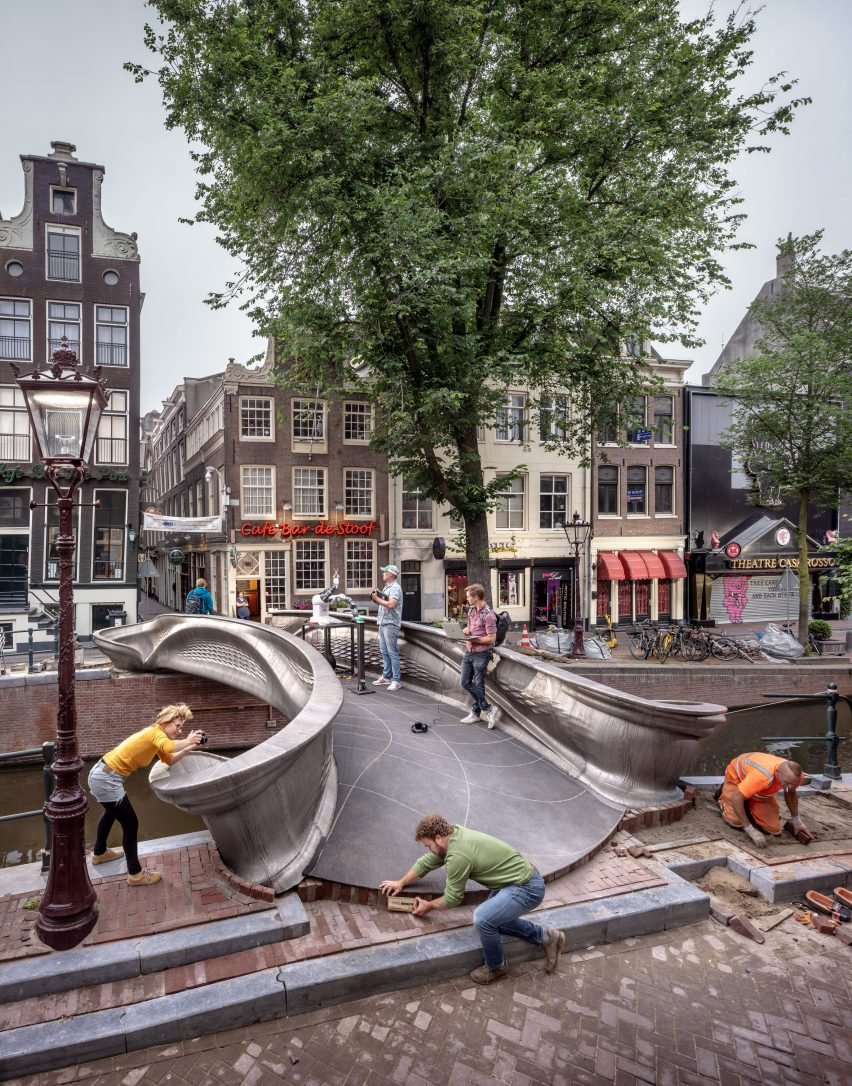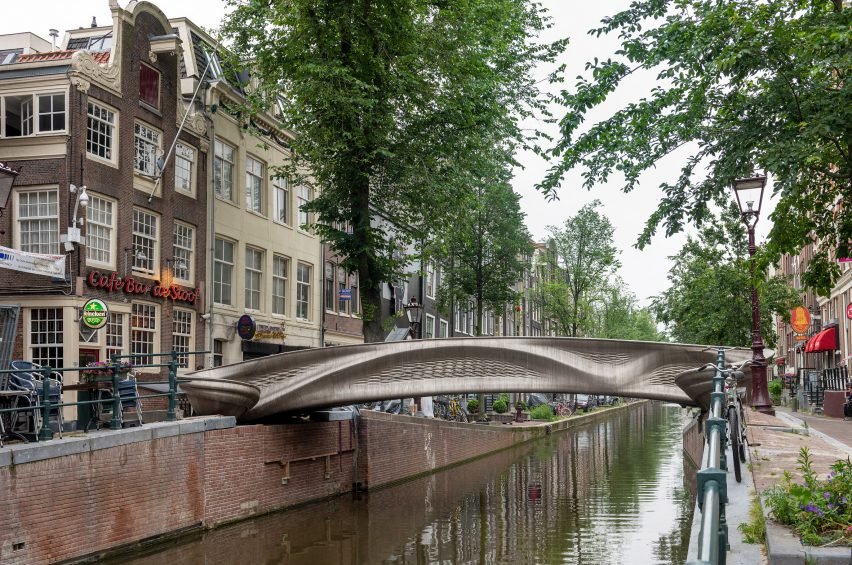
Joris Laarman 3D-Printed Bridge that Connects Technologies of the Future and Urban Fabrics of the Past
What is the future that our cities hold? It is impossible to anticipate how the urban fabric of cities will evolve through this digital era currently developing and bounding to everyday-life objects and spaces.
Joris Laarman has been looking and working towards the future in this sense, and his studio has recently completed the first fully 3D printed pedestrian bridge out of metal, located in Amsterdam.

The laboratory of this futuristic company is the experimenting and driving force behind this latest digitally built piece of infrastructure; they strive for technological research and curiosity that foresees the possibilities that it can generate in the built environment. For this reason, all of their ideas are always tested and developed physically, not only as digital prototypes; every iteration is explored and manufactured as if it was to be the final product, this allows them to understand the behaviour of their designs in the real world and at an appropriate scale.
The studio has a very forward-thinking understanding of how craftsmanship and technology can cooperate to generate augmented results; normal craftsmanship should not be perceived as something nostalgic, something irreplaceable by machines but rather something that is in constant evolution. From its very past until the industrial revolution and now, craftsmanship has changed, improved and has been permeable to innovations and high-tech tools should be appreciated as helping it be even more central in our society.
One of the main qualities of this studio laboratory, promoting the creation of such innovations able to challenge the way we see our cities, is represented by their desire to always push the limits of manufacturing, digital technology and architecture; this is carried out by hybridizing different apparatuses and machines resulting in the discovery of original systems for the future of city-making.

With this type of thinking in mind, Joris Laarman has finally finished the long process for the design and installation of the 3D printed bridge that connects two sides of the Oudezijds Achterburgwal canal in the Dutch city of Amsterdam.
The bridge took 18 months for its design, from engineering to programming, testing for safety measures, test-printing, re-designing and iterating multiple times and asking for permits for its installation. This long process conceals an even more complex one: the bridge construction in the lab. Joris Laarman, in collaboration with the Dutch robotics company MX3D, printed the 12-meter-long-profile structure using multiple robots simultaneously, with a total completion time of six months.
The complexity of the bridge is also enhanced by its smart qualities; in fact, its fitting with different sensors gives analytics on the use of the new piece of infrastructure, particularly on its physical status and interaction with people to predict faults and to maintain a healthy structure for the coming years. This is possible through algorithms embedded in the bridge capable of recognising its 3D-printed elements and components and correlating them to the functionality of the user and its surrounding environment.
The revolutionary element of this project is the metal 3D printer technologies; these particular machines are much larger than the standard typology, a further reason encouraging the company to experiment with this technology. The curiosity to expand these printers’ limits and knowledge, allowed the studio to test different commands and functionality so unconventionally that even welding experts witnessing the processes of the metal printers were astonished both by the innovation of the technology and for the unique settings use in printing the bridge, extremely different from the standard ones. This reinforces even further the notion that the introduction of innovative technologies in the craftsmanship industry is crucial for its survival and progression.
The idea of the 3D printed bridge derived from two important events that occurred in the company: the first is the work and design conducted on a previous project, the “Dragon Bench”, a sculptural piece created with an earlier version of MX3D metal printer.
Specifically, the printer able to create these innovative designs is composed of an industrial robot developed by the MX3D resin printer combined with a pioneering welding machine capable of printing steel, stainless steel, aluminium, bronze or copper without a supporting structure. The technology is further developed to be able to print curved lines in midair through the addition of molten metal. The potential of these machines is uncountable, the possibility to print intersecting elements and create large self-supporting objects is still an untapped technology in the digital design world.
Despite the complexity of the welding-3D printer powered by different types of software that simultaneously work on the object, the interface of this technology has to be user friendly and be able to print from CAD files, which was another challenge for the design studio.
The second reason the led to the creation of the bridge comes from a presentation about the 3D printers the design studio was asked to host in San Francisco, for its main sponsor, Autodesk; the idea came out from trying to create a poster for the presentation that embedded all of the elements of the printers but also the essence of the work pursued. At this point, the studio “came to the conclusion that a bridge over one of the old canals in Amsterdam would be a fantastic metaphor for connecting the technology of the future with the city’s past, in a way that would reveal the best aspects of both worlds.”

All of these elements and factors were employed and embodied by Joris Laarman and his studio; this innovative piece of infrastructure is able to create a special moment in the urban fabric of Amsterdam that gives us a hint of what the future of cities will look like. These projects become the grammar, the new visual language, the laboratory employees to continue experimenting towards new future craftsmanship for the city.

